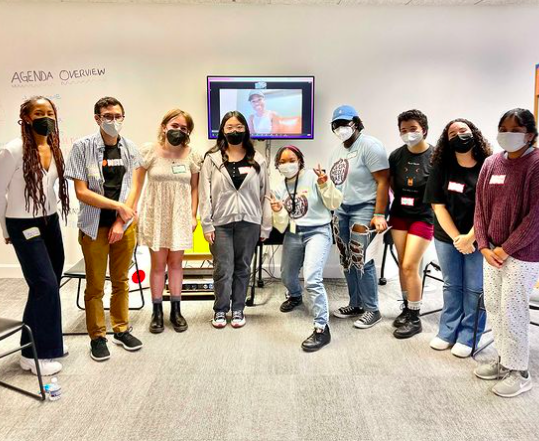I was sitting in my room when I had finished reading and decided to hop on YouTube. “Haitian Migrants Stranded in Tijuana” was in my most recommended. It caught my eye. As I watched the April 2017 video, I became confused and curious. People — mostly women and children who originally fled Haiti to try to get to the U.S. — stood in a crowded line at the U.S.-Mexico border, on the Mexican side in Tijuana. They were seeking asylum in the U.S. but might be stuck in Mexico. After watching this video, I had so many more questions than answers.
I’d heard about deportation and immigration — especially after president Trump’s controversial stance on immigration. “These aren’t people. These are animals” is what our 45th president said at the California Sanctuary State Roundtable in May 2018. I was shocked that he would let those words fall out of his mouth.
I had originally thought that deportation of people living in the U.S. illegally was fine because I assumed they went back to their home countries and were reunited with families they left behind. But seeing those videos from Tijuana, Mexico, and realizing that not everyone goes back to their countries, they’re targeted and in danger, I wondered what the deportation process was really like and where people go — especially teens.
To help clarify these answers, I called Sofia, a 19-year old DACA recipient, to get her perspective on living with undocumented parents and how the fear of deportation changed her life growing up in metro-Atlanta?
“I am a DACA holder, and both of my parents are here illegally,” said Sofia, whose parents brought her to the U.S. when she was 7. “Any simple traffic stop can result in them being deported. I have siblings that are underage, who would take care of them?”
DACA stands for Deferred Action for Childhood Arrivals, and it’s a program implemented during former President Barack Obama’s administration that allows young immigrants who were brought to the U.S. illegally as children remain in the U.S. and go to school or work. The program was ended by President Trump in 2017, so young people can renew their DACA status but no new applications are being accepted by U.S. Citizenship and Immigration Services (USCIS).
I asked Sofia what her plan would be if she were forced to leave the U.S. “I don’t know life outside of the U.S. If I were to go back to Mexico, I don’t have anyone there I can put my trust in,” she said.
“Having parents who are here illegally, your eyes are opened up to a lot of things. You learn what barriers your parents face and that you face … You have a lot of fear and a lot of fear for your parents, more than most children would at that age.”
“My friends have had loved ones who have gone through the [deportation] process, and all I can say is they don’t know where their family members are or where they are headed.”
I asked her the question that is at the heart of all this: “Do you know where immigrants go when they are deported?”
“Not precisely, no,” she responded.
To fill in the gap, I reached out to immigration attorneys to talk about the process of deportation and where deportees go after removal.
I wanted to get a legal definition of what deportation means. In an email, Carolina Antonini from the Antonini & Cohen Immigration Law Group answered, “For USA immigration law purposes, ‘deportation’ is the expulsion of … (a non-USA citizen) out of the country.”
“The proper language is ‘removal,’” Antonini also explained. “It used to be called ‘deportation’ until the Immigration Reform Act of 1996. Congress then changed the language from ‘deportation’ to removal.’”
I still wanted to understand where people go when they are “removed” from the US. “Most commonly [they go] to the country of their birth because that is the country that can issue travel documents for them,” Antonini wrote to me.
I asked Palmer Lawrence, a litigation fellow for Asian American Advancing Justice to go more in-depth about the “removal” process. “You get put on a plane, and the government pays for it. You are typically put in shackles, and you’re escorted by deportation officers. You don’t get to choose which city you’re taken to,” she said.
“You don’t have to give permission to be deported. Even if you physically resist, ICE (the U.S. Immigration and Customs Enforcement) can sedate you and put you on the plane and forcibly remove you from the United States. It’s usually these flights in the middle of the night and you’re not going to have very much notice, you don’t have a chance to have a last call to your family or attorney. “
The Department’s website says ICE’s Enforcement and Removal Operations “enforces the nation’s immigration laws in a fair and effective manner. It identifies and apprehends removable aliens, detains these individuals when necessary and removes illegal aliens from the United States.”
“Deportation isn’t just a gentle thing,” Lawrence said.
Raymond Partolan, an immigration paralegal with Kuck Baxter, says the way deportation works in the United States is pretty complicated. “There’s a lot of steps in the process. Within deportation or removal proceedings, there is no right to counsel – no constitutional right to have an attorney present.” He sees families come into contact with the U.S. court system every day. One of the myths is that individuals who are in court proceedings have a right to an attorney because that’s what we’re used to seeing in the U.S. criminal court system, where the constitution guarantees people can have an attorney, but in deportation or removal proceedings there is no right to an attorney.
“For people who are low income or otherwise don’t have access to legal services, it’s really difficult to fight deportation,” he says. For children or minors especially those who are separated from their families, “deportation rates are very high but they are mitigated when you add in the possibility of being represented by an attorney.”
“It really is about protecting people’s lives,” said Lawrence, “their human rights, their ability to live freely and openly with their politics, their sexual orientation, and their religion. The stakes are very high, and they’re very important.”
Not all immigrants who get deported go back to their home countries. Some go to Tijuana, Mexico. The Santa Cruz Sentinel reported last March, “Between 10 and 15 percent of all deportees from the U.S. are sent to Tijuana, whether they have any family or other ties here or not, according to immigration statistics compiled by Syracuse University.”
I asked Lawrence about Tijuana. “In Tijuana, there is a lot of criminal activity,’ she said. “Deportees are often targeted for violence for a couple reasons. They’re vulnerable, they’re easy to be robbed…There are stories of people being put into human trafficking and taken to other places in Mexico or somewhere else.”
After talking to Sofia, Ramond, Antonini, and Palmer, I came to the conclusion that even though people might not want to talk about deportation because it’s such a “sensitive topic,” it is still a topic that people need to get educated on.
 Rachel, 14, participated in VOX Media Cafe this summer and is creative — and weird.
Rachel, 14, participated in VOX Media Cafe this summer and is creative — and weird.




